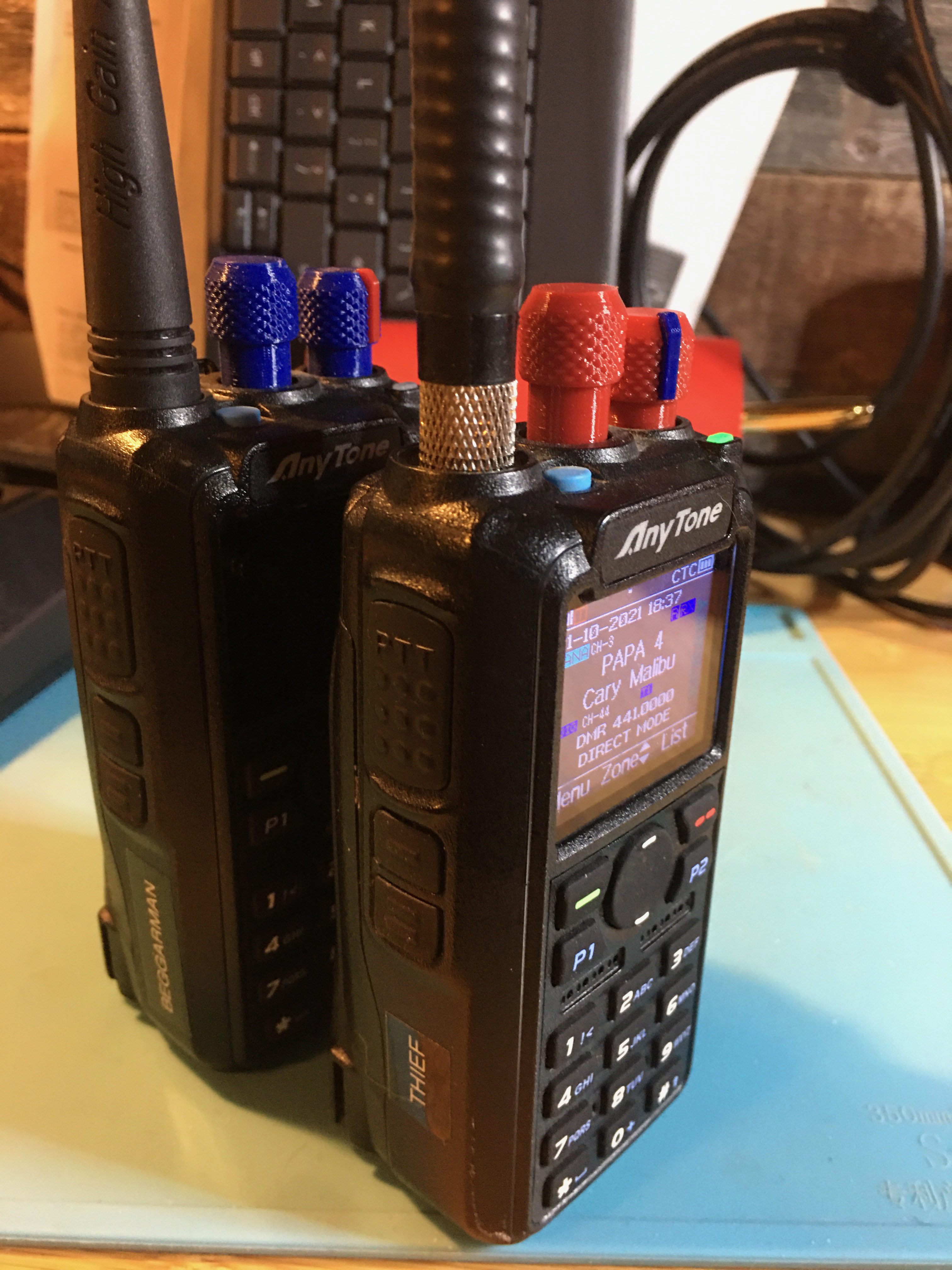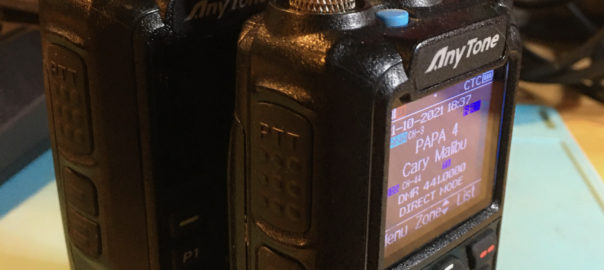Our Anytone “Every Day Carry” (EDC) radios – loud, large battery, field programmable and pretty sturdy.
Quick list of pros:
- Battery can last several days receiving and intermittent transmitting.
- Loud speaker and customizable, readable in sunlight display.
- Field programmable easily from the menus, but also has great CPS (Customer Programming Software), once you get experience with it (I needed 8 plus hours successful use).
- Has GPS & beacons your position on APRS or DPRS.
- Strong DMR messaging, which can make up somewhat for no APRS message sending, at least in a DMR repeater environment like SoCal.
- Moderately priced and relatively rugged.
- Hackable to add 220Mhz/1.25m band at .75w. Get a triband antenna, like Smiley.
- Bluetooth works well for handsfree hiking/biking/walking the dog.
Short list of cons:
- No APRS message sending (though new model can receive APRS messages).
- No Analog QSO recording.
- It’s a computer based SDR, so expect the occasional lock-up or unrequested reboot (rare, but they happen).
A few remarks:
This is my “getting there” radio on SOTA hikes, using any bluetooth earpiece and the supplied PTT button strapped onto my hiking pole. Walk all day and the battery is not depleted. I’ve loaded the local repeater association’s “codeplug” (i.e. saved channel list) and customized it to add many more analog and DMR simplex and repeater channels. I love DMR simplex for its clarity over longer ranges where FM would have lots of path noise.
I’m really really comfortable with this radio, have to say its my favorite for comfort, ease of use, flexibility, reliability and not dropping into some weird feature mode when I need it to work normally (*glares at FT3D*).
A DMR codeplug, which is the channel & radio option configurations is something you can create, download or upload to the radio with the CPS. Figuring out this configuration and how to work with it can be frustrating. Here are my tips for success:
- Get a neighbors codeplug, change the RadioID to your RadioID and load it, so that you have a working radio for your area.
- Some people insist that the only learn to use DMR is to program your own codeplug from scratch. I come from an IT background where we say “great programmers steal great code”. You learn by copying the best. In DMR, get a working radio first (#1 above), then do #3 below.
- Start adding/changing things in the codeplug with the CPS like this: SAVE the working codeplug to disk in a name that contains a timestamp like YYYYMMDDHHMM (year, month, day); CHANGE one thing in the current codeplug; UPLOAD changed codeplug from CPS to radio and test; IF IT WORKS, “save as”, updating the timestamp; IF IT DOESN’T WORK, try again and if necessary, UPLOAD the previously working codeplug with the prior timestamp.
- Keep your timestamped codeplugs and prior version CPS as backups. The codeplugs don’t take much space on a modern disk. Being able to go back to one that worked before you updated that software in the radio/CPS is a lifesaver.
Info LInks:
- Christian Claiborne N1CLC has a great write up on the Anytones.
Accessories:
- 3D printed knobs from Thingiverse printed by OkaySharpei 3D (see pictures).
- Smiley Tri-band Antenna for the “Band 14” hack using Anytone’s AT Options software (ask your dealer).
- Powerwerx BLUE-AT Bluetooth Style Earpiece for Anytone AT-D878UV-BT with PTT.
ToDo:
- Add my most called people by ID/Callsign as channels to the local repeaters, simplex channels and our hotspot as a zone to facilitate private calls.
- Practice private call on repeater and DMR simplex with KC6CLC. This is for future emergency communications (EMCOMM) and also spotting for parking the future RV when there’s no cell service.
- Find a way to filter RadioID downloads so they fit in the capacity for these radios.

